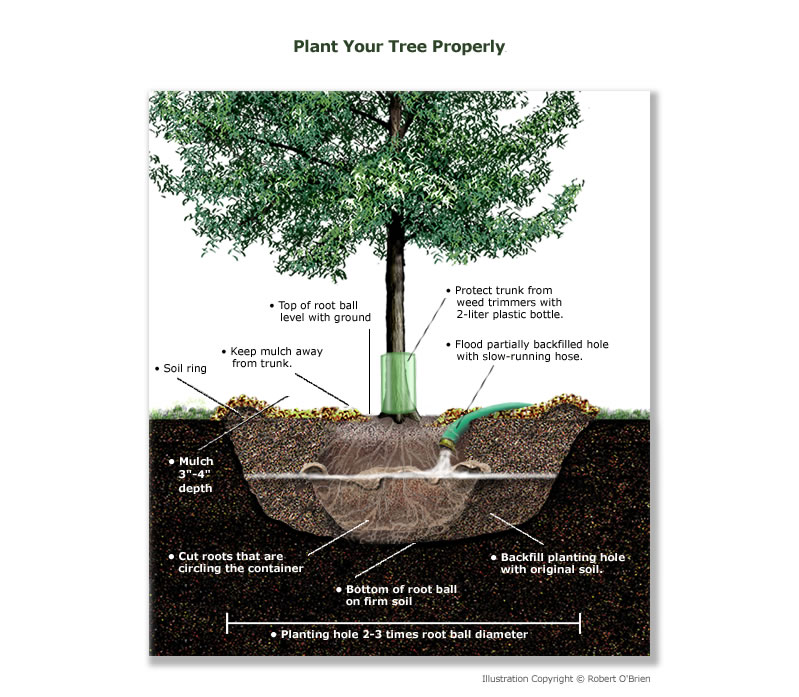.jpg) Questions about trees are by far the most common questions we get at the Extension Office. Trees that are showing symptoms of problems can also be the most difficult to diagnosis. The health of trees is directly related to stress. So what causes stress in trees? In my experience, water issues are the most common stresses. Drought stress has plagued many of our trees in North Texas. Trees are among the toughest plants on Earth but they don't always give us clues they are struggling until it is too late. Other environmental conditions can cause stress on trees and reduce their ability to defend themselves against diseases and insect damage. There are numerous diseases and insects that cause problems with trees. However, two pests tend to attack tree more often during stressful conditions. Hypoxylon Canker is a fungal disease that will kill a tree that is stressed. Wood-boring insects are the most common insect we see killing trees in Collin County. The most important thing you can do to protect the health of your tree is to prevent trees from becoming stressed. Learn more at the Texas A&M Forest Service - Forest Health website.
Questions about trees are by far the most common questions we get at the Extension Office. Trees that are showing symptoms of problems can also be the most difficult to diagnosis. The health of trees is directly related to stress. So what causes stress in trees? In my experience, water issues are the most common stresses. Drought stress has plagued many of our trees in North Texas. Trees are among the toughest plants on Earth but they don't always give us clues they are struggling until it is too late. Other environmental conditions can cause stress on trees and reduce their ability to defend themselves against diseases and insect damage. There are numerous diseases and insects that cause problems with trees. However, two pests tend to attack tree more often during stressful conditions. Hypoxylon Canker is a fungal disease that will kill a tree that is stressed. Wood-boring insects are the most common insect we see killing trees in Collin County. The most important thing you can do to protect the health of your tree is to prevent trees from becoming stressed. Learn more at the Texas A&M Forest Service - Forest Health website.Watering a Tree
During times of drought, I recommend watering a tree at least once per month by irrigating the top 6 inches of soil within the drip line of the tree (area under the canopy). Most homeowners believe a tree gets enough water from a lawn sprinkler system, but these type of irrigation systems are designed to irrigate turfgrass, not trees. Trees require a irrigation method that allows the water to slowly penetrate deep within the soil profile. The majority of the tree roots are within the top 6 or 12 inches of the soil, so when we irrigate we need to water that profile. Hand watering trees is practical, but if you use a irrigation system then select drip tubing, bubblers, and other device specifically designed for trees. The Texas Forest Service has great video on how to water your tree.
Tree Selection and Planting
Trees are an important part of our landscapes and the natural environment. Fall is a great time of the year to plant a tree. A tree planted in the fall has a better chance of getting established, than any other time of the year. If you are going to plant a new tree or you are replacing a dead tree, there are many important things to consider. The Collin County Master Gardeners provide resources on selecting the proper tree. The Texas A&M Forest Service has educational videos and Tree Planting website that help make your next tree planting a success.
Removing a Tree
Trees provide countless benefits to humans and the environment. The loss of a tree within your landscape can be difficult. It is important to understand the risk that dead, damaged, or weak trees can have to your neighborhood and surrounding property. The Texas A&M Forest Service publication provide information on Liability of Hazardous Trees. During the process of removing a tree, one of the most importance considerations is selecting a Tree Care Professional to remove the tree. This publication provides advice on how to select a professional. I recommend using a Certified Arborist that has the proper insurance, professional references, and recommendations from trusted sources. You can find a Certified Arborist at the International Society of Arboriculture.
Written by Greg Church, Ph.D. - Horticulture Agent, Texas A&M AgriLife Extension

No comments:
Post a Comment